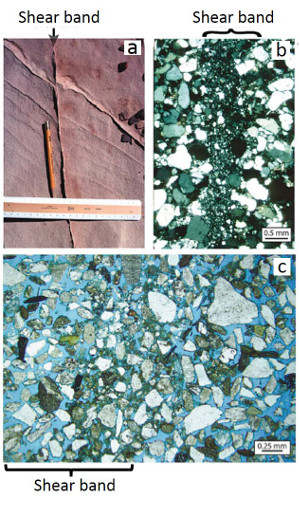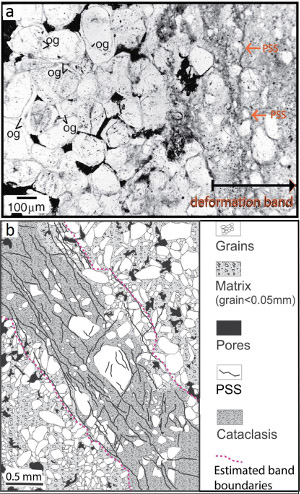|
Shear strain localization into narrow bands either by bifurcation (see the Cap model under 'Mechanisms and Mechanics of Deformation Bands') or initiation and growth of flaws such as pore collapse is responsible for the formation of shear bands. The micromechanical process is referred to as cataclasis involving grain fracturing and grain size reduction, and change of pore space or change of porosity. They usually have a texture recognizable under microscope (Figure 1b).
 | | Figure 1. (a) Outcrop photo showing a shear band (arrow) in Entrada sandstone, San Rafael Desert, Utah. The band shows a few mm left lateral slip. (b) Thin section image of a shear band (arrow) marked by a smaller grain size (i.e., cataclasis) in Entrada Sandstone in San Rafael Desert. (c) A shear band without cataclasis in unconsolidated sediments, McKinleyville, northern California. |
However, shear bands also form without grain fracturing through grain motion, grain rotation, and change of pore space (Figure 1c). This process is known as particulate flow which is well-known for deformation of granular materials including loose sand or sediments without any significant cement. This is as opposed to cataclasis described under 'Cataclastic Flow.' Some shear bands may also be involved in pressure solution as shown in Figures 2a and 2b in sandstone and carbonate grainstone, respectively, subjected to relatively high confining pressure.
 | | Figure 2. Shear bands with pervasive overgrowth (og) and pressure soluton seams (PSS) in silicaclastic Navajo Sandstone (a) in the San Rafael Swell, Utah and in carbonate grainstone of the Orfento Formation in Majella anticline, southern Apennines, Italy (b), respectively. (a) from Davatzes et al. (2003); and (b) from Tondi et al. (2006). |
| |
Aydin, A., Borja, R., Eichhubl, P., 2006. Geological and mathematical framework for failure modes in granular rock. Journal of Structural Geology 28 (1): 83-98.
Borradela, G.J., 1981. Particulate flow of rock and the formation of cleavage. Tectonophysics 72: 305-321.
Cashman, S., Cashman, K., 2000. Cataclasis and deformation-band formation in unconsolidated marine terrace sand, Humboldt County, California. Geology 28: 111-114.
Curran, J.H., Carroll, M.M., 1979. Shear enhancement of void compaction. Journal of Geophysical Research 84: 1105–1112.
Davatzes, N.C., Aydin, A., Eichhubl, P., 2003. Overprinting Faulting Mechanisms During the Development of Multiple Fault Sets in Sandstone, Chimney Rock, Utah. Tectonophysics 363: 1-18.
Du Bernard, X., Maerten, F., 2001. Dynamic Element Modeling of Stress Field and Arrangement Evolutions Within a Quartz Grain Aggregate. Stanford Digital Repository. Available at: http://purl.stanford.edu/vj755vz8779.
Du Bernard, X., Eichhubl, P., Aydin, A., 2002. Dilation bands: a new form of localized failure in granular media. Geophysical Research Letters 29 (24): 2176 doi: 1029/2002GLO15966.
Tondi, E., Antonellini, M., Aydin, A., Marchegiani, L., Cello, G., 2006. The role of deformation bands, stylolites and sheared stylolites in fault development in carbonate grainstones of Majella Mountain, Italy. Journal of Structural Geology 28 (3): 376-391.
Vermeer, P.A., Diebels, W.E., Ehlers, W., Herrmann, H.J., Luding, S., Ramm, E., 2001. Continuous and Discontinuous Modelling of Cohesive-Frictional Materials. Springer, 310p.
Viggiani, G., Kuntz, M., Desrues, J., 2008. An experimental investigation of the relationships between grain size distribution and shear banding in sand, 111-127: In: P.A. Vermeer, S. Diebels, W. Ehlers, H.J. Herrmann, S. Luding, E. Ramm (Eds.), Continuous and Discontinuous Modelling of Cohesive-Frictional Materials. Springer, 310p.
|

